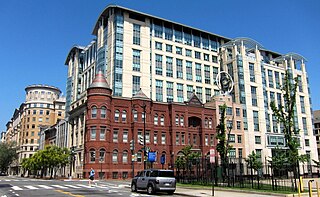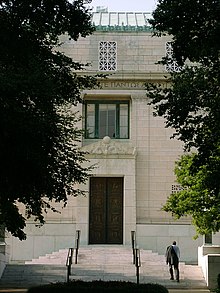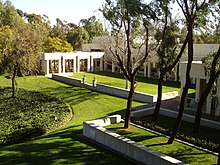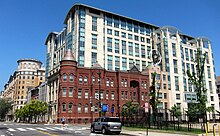
Frederick Seitz was an American physicist, tobacco industry lobbyist, climate change denier and former head of the United States National Academy of Sciences. Seitz was the 4th president of Rockefeller University from 1968 to 1978, and the 17th president of the United States National Academy of Sciences from 1962 to 1969. Seitz was the recipient of the National Medal of Science, NASA's Distinguished Public Service Award, and other honors.

The National Academies of Sciences, Engineering, and Medicine (NASEM), also known as the National Academies, is a congressionally chartered organization that serves as the collective scientific national academy of the United States. The name is used interchangeably in two senses: (1) as an umbrella term or parent organization for its three sub-divisions that operate as quasi-independent honorific learned society member organizations known as the National Academy of Sciences (NAS), the National Academy of Engineering (NAE), and the National Academy of Medicine (NAM); and (2) as the brand for studies and reports issued by the unified operating arm of the three academies originally known as the National Research Council (NRC). The National Academies also serve as public policy advisors, research institutes, think tanks, and public administration consultants on issues of public importance or on request by the government.

Alexander Dallas Bache was an American physicist, scientist, and surveyor who erected coastal fortifications and conducted a detailed survey to map the mideastern United States coastline. Originally an army engineer, he later became Superintendent of the United States Coast Survey, and built it into the foremost scientific institution in the country before the American Civil War.

Michael Evan Mann is an American climatologist and geophysicist. He is the director of the Center for Science, Sustainability & the Media at the University of Pennsylvania. Mann has contributed to the scientific understanding of historic climate change based on the temperature record of the past thousand years. He has pioneered techniques to find patterns in past climate change and to isolate climate signals from noisy data.
An academician is a full member of an artistic, literary, engineering, or scientific academy. In many countries, it is an honorific title used to denote a full member of an academy that has a strong influence on national scientific life.
The National Academy of Medicine (NAM), known as the Institute of Medicine (IoM) until 2015, is an American nonprofit, non-governmental organization. The National Academy of Medicine is a part of the National Academies of Sciences, Engineering, and Medicine, along with the National Academy of Sciences (NAS), National Academy of Engineering (NAE), and the National Research Council (NRC).

The American Geophysical Union (AGU) is a 501(c)(3) nonprofit organization of Earth, atmospheric, ocean, hydrologic, space, and planetary scientists and enthusiasts that according to their website includes 130,000 people. AGU's activities are focused on the organization and dissemination of scientific information in the interdisciplinary and international fields within the Earth and space sciences. The geophysical sciences involve four fundamental areas: atmospheric and ocean sciences; solid-Earth sciences; hydrologic sciences; and space sciences. The organization's headquarters is located on Florida Avenue in Washington, D.C.

Ralph John Cicerone was an American atmospheric scientist and administrator. From 1998 to 2005, he was the chancellor of the University of California, Irvine. From 2005 to 2016, he was the president of the National Academy of Sciences (NAS). He was a "renowned authority" on climate change and atmospheric chemistry, and issued an early warning about the grave potential risks of climate change.
The Alexander Agassiz Medal is awarded every three years by the U.S. National Academy of Sciences for an original contribution in the science of oceanography. It was established in 1911 by Sir John Murray in honor of his friend, the scientist Alexander Agassiz.

The New York Academy of Sciences is a nonprofit professional society with the mission to advance scientific research and knowledge, support scientific literacy, and promote science-based solutions to global challenges. Founded in January 1817 as the Lyceum of Natural History, it is the fourth-oldest scientific society in the United States. The academy has more than 20,000 members in 100 countries.
The National Academy of Engineering (NAE) is an American nonprofit, non-governmental organization. The National Academy of Engineering is part of the National Academies of Sciences, Engineering, and Medicine, along with the National Academy of Sciences (NAS), the National Academy of Medicine, and the National Research Council.
Walter Clarkson Pitman III was an American geophysicist and a professor emeritus at Columbia University. His measurements of magnetic anomalies on the ocean floor supported the Morley–Vine–Matthews hypothesis explaining seafloor spreading. With William Ryan, he developed the Black Sea deluge theory. Among his major awards are the Alexander Agassiz Medal and the Vetlesen Prize.
The Scientific Lazzaroni is a self-mocking name adopted by Alexander Dallas Bache and his group of scientists who flourished before and up to the American Civil War. These scientists then gained greater support and laid the foundation for the National Academy of Sciences. However, the National Academy did not solve the problems facing a nation plunged in Civil War – as the Lazzaroni had hoped, nor did it centralize American scientific efforts.

The Berlin-Brandenburg Academy of Sciences and Humanities, abbreviated BBAW, is the official academic society for the natural sciences and humanities for the German states of Berlin and Brandenburg. Housed in three locations in and around Berlin, Germany, the BBAW is the largest non-university humanities research institute in the region.
Satya Atluri was an Indian American engineer, educator, researcher and scientist in aerospace engineering, mechanical engineering and computational sciences, who was a Distinguished Professor Emeritus of Aerospace Engineering at the University of California, Irvine. Since 1966, he made fundamental contributions to the development of finite element methods, boundary element methods, Meshless Local Petrov-Galerkin (MLPG) methods, Fragile Points Methods (FPM), Local Variational Iteration Methods, for general problems of engineering, solid mechanics, fluid dynamics, heat transfer, flexoelectricity, ferromagnetics, gradient and nonlocal theories, nonlinear dynamics, shell theories, micromechanics of materials, structural integrity and damage tolerance, Orbital mechanics, Astrodynamics, digital Twins of Aerospace Systems, etc.

Eric J. Rignot is the Donald Bren, Distinguished and Chancellor Professor of Earth system science at the University of California, Irvine, and a Senior Research Scientist for the Radar Science and Engineering Section at NASA's Jet Propulsion Laboratory. He studies the interaction of the polar ice sheets in Greenland and Antarctica with global climate using a combination of satellite remote sensing, airborne remote sensing, understanding of physical processes controlling glacier flow and ice melt in the ocean, field methods, and climate modeling. He was elected at the National_Academy_of_Sciences in 2018.

Warren Morton Washington is an American atmospheric scientist, a former chair of the National Science Board, and currently a Distinguished Scholar at the National Center for Atmospheric Research (NCAR) in Boulder, Colorado.
The Attorney General of Virginia's climate science investigation was a civil investigative demand initiated in April 2010 by Virginia Attorney General Ken Cuccinelli, who rejects the scientific consensus on climate change, for a wide range of records held by the University of Virginia related to five grant applications for research work by a leading climate scientist Michael E. Mann, who was an assistant professor at the university from 1999 to 2005. The demand was issued under the Virginia Fraud Against Taxpayers Act in connection with claims by Cuccinnelli that Mann had possibly violated state fraud laws in relation to five research grants, by allegedly manipulating data. No evidence of wrongdoing was presented to support the claim. Mann's earlier work had been targeted by climate change deniers attacking the hockey stick graph, and allegations against him were renewed in late 2009 in the Climatic Research Unit email controversy but found to be groundless in a series of investigations.
Goverdhan Mehta FNA, FASc, FTWAS, FRS, FRSC is an Indian researcher and scientist.

Membership of the National Academy of Sciences is an award granted to scientists that the National Academy of Sciences (NAS) of the United States judges to have made “distinguished and continuing achievements in original research”. Membership is a mark of excellence in science and one of the highest honors that a scientist can receive.













